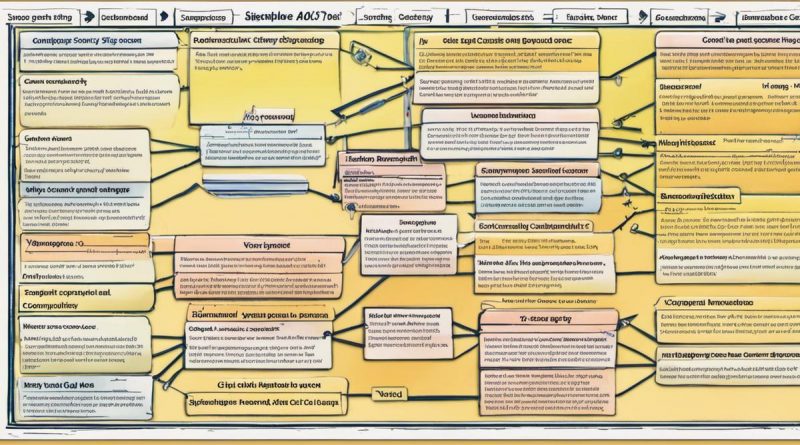Mastering Basic Sentence Patterns for TOEFL Success
Embarking on the journey of the TOEFL exam preparation, it becomes essential to master some key areas of the English language to attain proficiency. One such crucial sector is the understanding of basic sentence structures. Comprising of simple, compound, complex, and compound-complex sentences, a thorough comprehension of these formats will enhance your performance in both speaking and writing sections of the exam. We shall also delve into the importance of using TOEFL sample questions as a tool for assessment and overall confidence building. Simultaneously, we will explore the intrigue of applying these sentence patterns within various contexts and the role of self-assessment in this process.
Understanding Sentence Structures
Understanding Simple Sentences for TOEFL
A simple sentence, also known as an independent clause, consists of a subject and a predicate. The subject refers to the person, place, thing, or idea that the sentence is about. The predicate, on the other hand, expresses what is said about the subject. It includes the verb and any related information. For instance, in the sentence “Jane reads books,” “Jane” is the subject and “reads books” is the predicate. Understanding this basic sentence structure is a crucial step towards achieving success in the TOEFL.
Mastering Compound Sentences in TOEFL
Compound sentences are formed by combining two or more simple sentences using coordinating conjunctions such as ‘and’, ‘but’, ‘or’, ‘so’, ‘yet’, ‘for’, and ‘nor’. An example would be, “Liam enjoys playing guitar, and he often performs at local cafés.” Each clause in a compound sentence could stand as a complete sentence on its own. Knowing how to properly use these conjunctions to form compound sentences can enhance your TOEFL scores, as it demonstrates your capability to convey complex thoughts and ideas in English.
The Art of Forming Complex Sentences for TOEFL
Complex sentences comprise a main clause (also known as an independent clause) and one or more dependent clauses. A dependent clause cannot stand alone as a complete sentence. They are typically joined with subordinating conjunctions such as ‘although’, ‘since’, ‘if’, ‘when’, or ‘because’. For example, “Although it was raining, she decided to go for a walk.” Here, “she decided to go for a walk” could stand alone as a complete sentence, while “Although it was raining” cannot. Such sentences are key to demonstrating mastery of the English language in the TOEFL.
Navigating Compound-Complex Sentences in the TOEFL
The compound-complex sentence comprises at least two independent clauses and one or more dependent clauses. Consider the sentence, “David cooked dinner, and he cleaned up the kitchen afterwards because he wanted to surprise his wife.” Here, “David cooked dinner” and “he cleaned up the kitchen afterwards” are the independent clauses, while “because he wanted to surprise his wife” is a dependent clause. Crafting such sentences accurately demonstrates your fluency in English and will prove beneficial in the TOEFL speaking and writing sections.

Practicing TOEFL Sample Questions
TOEFL Sample Questions: Written and Spoken Sections
Candidates preparing for the Test of English as a Foreign Language (TOEFL) must have a clear understanding of basic sentence patterns. One effective way to gain this understanding is through practising with sample TOEFL questions. These can be found in TOEFL preparation books, online resources or in study guides. They are designed to mimic the format of the actual examination, presenting scenarios that learners may encounter on exam day.
Recognising Basic Sentence Patterns
Familiarising yourself with basic sentence patterns is a significant step toward achieving a better score on the written and spoken sections of the TOEFL. These patterns include simple, complex, compound, and compound-complex sentences. Note the use of coordinating and subordinating conjunctions, punctuation, and sentence structure. Be aware that the TOEFL exam requires the ability to understand and apply various sentence patterns in practical situations.
Practicing Written Section of TOEFL
One viable way of learning is through self-practice. Begin by opting for short tasks, such as writing a paragraph or an informal letter using the identified sentence patterns. As confidence increases, proceed to longer compositions or essays, and always seek feedback on your work. Consider using online tools which can highlight issues with sentence structure, grammar, punctuation, and vocabulary.
Practicing Spoken Section of TOEFL
Unlike the written practice, the spoken section demands a real-time application of sentence patterns. Start your practice with simple conversations or presentations. Record your spoken practice for review, noting any recurring mistakes to rectify in future practices.
Reflecting on Performance
Reflection is a vital part of effective learning. After each practice session, analyse your performance. Identify areas where further improvement is needed, such as specific sentence structures or vocabulary usage. Make a learning timetable, ensuring it includes feedback times, and stick to it.
Repetition and Review
Repetition and review are key for embedding any new learning. Regularly returning to previously covered sentence patterns helps to prevent forgetting and promotes long-term retention. Avoid cramming, instead, spread out learning sessions and reviews over time.
Use Practice Exams to Your Advantage
Finally, consider taking timed practice exams under conditions that simulate the actual test environment. This will provide a sense of the pressure one might experience during the exam and help you better manage your time. Remember, practice makes perfect, and with diligent preparation, tackling the TOEFL can become a more manageable task.

Applying Sentence Patterns in Context
Understanding Basic Sentence Patterns
One must first understand what a basic sentence pattern is. In English, there are five basic sentence patterns, each with a distinctive structure: Subject-Verb (S-V), Subject-Verb-Object (S-V-O), Subject-Verb-Indirect Object-Direct Object (S-V-IO-DO), Subject-Verb-Complement (S-V-C), and Subject-Verb-Direct Object-Object Complement (S-V-DO-OC). These formations assist in the accurate comprehension of English grammar terms and their organisation. Once you identify these patterns, practising them in various contexts will increase your written and spoken fluacy with the language.
Applying Sentence Patterns in Writing And Speech
To apply basic sentence patterns, start by creating your own sentences. Using a novel, newspaper, or academic text, identify the different types of sentences and see how they are structured. Notice how the author varied sentence types to make the writing more engaging. Try rewriting some of these sentences using different patterns to understand how it changes the meaning or tone of the sentence.
Practicing Sentence Patterns
The key to mastering the application of basic sentence patterns is practice. Work on forming sentences of each pattern daily, making sure to vary the subjects and verbs you’re using. Create a sentence journal where you write down new sentences you’ve formed, which can be used as a reference for future studies.
Identifying Sentence Patterns
To identify sentence patterns in speech or writing, you need to understand the key components of a sentence. The subject (S) refers to who or what the sentence is about. The verb (V) represents what the subject is doing or being. The object (O) receives the action performed by the subject. The indirect object (IO) benefits from the action. The complement (C) describes the subject or object, while the object complement (OC) describes or renames the object.
Boosting Sentence Pattern Recognition
You will improve your sentence pattern recognition by reading a wide range of texts and paying attention to how sentences are structured. It’s also beneficial to listen to spoken English in different contexts – conversations, speeches, radio broadcasts, etc. – and identify the sentence patterns used.
Strengthening Sentence Pattern Application
Utilising sentence patterns in your writing or speaking can be strengthened through peer evaluation. Having others to review your work can provide different perspectives on sentence structure, coherence, and clarity. Joining a study group, reaching out to a mentor, or employing the use of online tools and platforms can expedite this process.
Remember: mastering the application of basic sentence patterns for TOEFL will not only boost your score but will also improve your overall competence in English. Regular practice, reading, and listening to the language in different contexts will strengthen your understanding and usage. Peer feedback will also provide valuable insights into your progress and areas for improvement.

Review and Self-Assessment
To begin reviewing for the TOEFL, it is crucial to first understand sentence patterns. A sentence pattern is essentially the order and structure in which words are organized to form a meaningful sentence. In English, there are five main sentence patterns. Familiarising yourself with these basic sentence patterns can assist in enhancing your writing and speaking skills for the TOEFL.
Once you have taken the time to understand and practise these common sentence patterns, assess your progress. This can involve writing practice sentences using each pattern and then evaluating how close your sentences adhere to the model examples. Be sure to pay attention to the correct placement of the subject, verb and object in each pattern.
After a period of self-study, conduct a self-assessment. Pinpoint the sentence patterns that give you the most trouble. Are there certain patterns that consistently confuse you? Do you struggle with long, complex forms? Or is your difficulty in the placement of adjectives or prepositional phrases? Once you have identified these patterns, you can deliberately focus on practising and improving them.
After recognising areas of difficulty, devise a strategy for improvement. This might involve crafting more practice sentences, breaking down complex sentence structures into simpler ones, or seeking further clarification and guidance on those patterns.
If you have additional time, employ it efficiently to enhance your skills. Continue reviewing other aspects of the TOEFL that require strengthening, such as vocabulary, grammar, and listening skills. Remember, thorough understanding and mastery of sentence patterns are only part of the bigger picture in excelling at the TOEFL.
Finally, make regular self-assessment a habit. The improvement of sentence patterns is a gradual process, not something that can be achieved overnight. Regular assessments allow you to track your progress and continually identify areas for improvement. It also enables you to gauge your readiness for the TOEFL.

Once you have engaged with an in-depth study of sentence structures, applied necessary corrections through practice, and established an understanding of their usage in diverse contexts, the resultant outcome evolves into a substantive enhancement of your language skills. However, the process does not end here. The final and equally significant step is the act of evaluation, execution of a comprehensive self-assessment. This phase will allow you to recognize your weak spots and devise precise strategies to overcome them. Ensuring you utilise the remaining time shrewdly, this part of the progression will serve as a stepping stone to achieving your desired TOEFL score, leading to your overall growth as a competent English speaker and writer.
Writio is an AI content writer that crafts top-notch articles tailored to your preferences. This article was written by Writio, your trusted AI writer.
